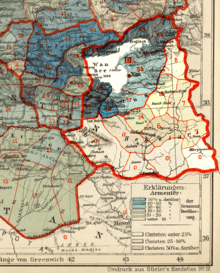Van Vilayet
| ولايت وان Vilâyet-i Van | |||||
| Vilayet of the Ottoman Empire | |||||
| |||||
.svg.png) | |||||
| Capital | Van[1] | ||||
| History | |||||
| • | Established | 1875 | |||
| • | Disestablished | 1922 | |||
| Population | |||||
| • | Muslim, 1914[2] | 179,380 | |||
| • | Armenian, 1914[2] | 67,792 | |||
| • | Jewish, 1914[2] | 1,383 | |||
| Today part of | | ||||
The Vilayet of Van[1] (ولايت وان, Vilâyet-i Van; Armenian: Վանի վիլայեթ, Vani vilayet') was a first-level administrative division (vilayet) of the Ottoman Empire. At the beginning of the 20th century it reportedly had a population of about 400,000 and an area of 15,000 square miles (39,000 km2).[1] It was one of the so-called six Armenian vilayets and held, prior to World War I, a large number of Armenians, as well as Assyrian and Azeri minorities.
History
In 1875 the eyalet of Erzurum was divided in six vilayets: Erzurum, Van, Hakkari, Bitlis, Hozat (Dersim) and Kars-Çildir. In 1888 by an imperial order Hakkari was joined to the vilayet of Van, and Hozat to Mamuret ul-Aziz.[3]
The economic center of province was the city of Van. As the border province of the north-eastern frontier, towards both Russian and Persian territory, it contained a number of garrisons. It was divided into the Sanjak of Van and the Sanjak of Hakkari and covered the present-day provinces of Van, Hakkari and parts of Şırnak, Muş and Bingöl ones.
Demographics
_2.664_Van_Vilayet.jpg)

At the beginning of the 20th century it reportedly had an area of 15,440 square miles (40,000 km2), while the preliminary results of the first Ottoman census of 1885 (published in 1908) gave the population as 376,297.[4] It should be noted that the accuracy of the population figures ranges from "approximate" to "merely conjectural" depending on the region from which they were gathered.[4]
Based on the official 1914 Ottoman Census the population of Van province consisted of 179,422 Muslims and 67,797 Armenians.[5] The Ottoman Census figures include only male citizens, excluding women and children. According to Armenian Patriarch of Constantinople, the corrected estimates for Van province (including women and children) was; 313,000 Muslims, 130,000 Armenians, and 65,000 others, including Syriac Christians and Nestorians.[6]
Geography
Vilayet of Van lay along the Persian frontier between the vilayets of Erzurum and Mosul. The northern sanjak comprised open plateau country N. and E. of the lake (with a large Armenian agricultural population and Kurdish seminomad tribes occupied chiefly in cattle and sheep raising), also of several fertile districts along the south shore of the lake. The southern sanjak was entirely mountainous, little developed and having the tribes only partly under government control. This comprised most of the upper basin of the Great Zab, with the country of the Nestorian Christians and many districts inhabited by Kurdish tribes, some of them large nomad tribes who descended for the winter to the plains of the Tigris.
The mineral wealth of the vilayet was never fully explored, but was believed to be great. There were petroleum springs at Kordzot, deposits of lignite at Sivan (now Avnik village in Bingöl) and Nurduz, several hot springs at Zilan Creek and Julamerk (Now Hakkari). Excellent tobacco was grown in Shemsdinan for export to Persia.
Administrative divisions
Sanjaks of the Vilayet:[7]
- Sanjak of Van (Van, Erciş, Çatak, Adilcevaz, Gevaş)
- Sanjak of Hakkari (Başkale, Hakkâri, Özalp, Şemdinli, Yüksekova, Gürpınar)
Economy
Historically, Vilayet produced millet.[8] It was also a major wine producer. Both wine and brandy were made in small amounts. The vilayet also produced flax and hemp.[9] Van also had a major sheep herding industry. As of 1906, there were over 3 million sheep in the vilayet. As of 1920, those numbers were reduced.[10] Beekeeping was done by peasants, with honey being frozen and sold.[11] The area also produced coal, lead, copper and borax, orpiment, gas, granite, lime, chalk, gypsum, gold, and salt.[12]
References
- 1 2 3 Geographical Dictionary of the World, p. 1909, at Google Books
- 1 2 3 "1914 Census Statistics" (PDF). Turkish General Staff. pp. 605–606. Retrieved 29 January 2011.
- ↑ Krikorian, Mesrob K. Armenians in the Service of the Ottoman Empire: 1860-1908.
- 1 2 Asia by A. H. Keane, page 460
- ↑ Values as printed on Image:Proportions des populations en Asie Mineure statistique officielle d1914.png
- ↑ Muslims and Minorities, Justin McCarthy, New York University Press, 1983, pp. 110-111
- ↑ Van Vilayeti | Tarih ve Medeniyet
- ↑ Prothero, W.G. (1920). Armenia and Kurdistan. London: H.M. Stationery Office. p. 60.
- ↑ Prothero, W.G. (1920). Armenia and Kurdistan. London: H.M. Stationery Office. p. 62.
- ↑ Prothero, W.G. (1920). Armenia and Kurdistan. London: H.M. Stationery Office. p. 63.
- ↑ Prothero, W.G. (1920). Armenia and Kurdistan. London: H.M. Stationery Office. p. 64.
- ↑ Prothero, W.G. (1920). Armenia and Kurdistan. London: H.M. Stationery Office. pp. 70–71.
External links
-
 Chisholm, Hugh, ed. (1911). "Van, Turkey". Encyclopædia Britannica (11th ed.). Cambridge University Press.
Chisholm, Hugh, ed. (1911). "Van, Turkey". Encyclopædia Britannica (11th ed.). Cambridge University Press. -
 Media related to Vilayet of Van at Wikimedia Commons
Media related to Vilayet of Van at Wikimedia Commons